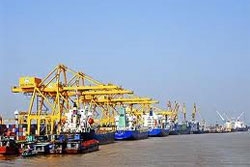Lach Huyen port close to reality
 |
| Lach Huyen port - illustration photo |
Chairman of Haiphong People’s Committee Duong Anh Dien said the detailed design for the Lach Huyen international port would be released between March and November 2011.
According to the Japanese embassy in Vietnam, both sides have been preparing an agreement document for the extension of the Lach Huyen port’s scope, which was proposed by the Japanese investors in order to receive big vessels in the future.
The proposal was already approved by the Vietnamese government.
Japanese contractors including Mitsui O.S.K Lines (MOL), Nippon Yussen Kaisha and Itochu recently suggested Vietnamese authorities to adjust the project’s scope in consideration of the future cargo throughput forecast.
Accordingly, the first two terminals are designed for accommodation of 100,000 tonne vessels with standard channel of 160 metres in width, 14m in depth, breakwaters of 760m and 3,200m in length.
The Vietnamese government allowed a pilot investment form of public-private partnership (PPP) to build the two first terminals.
Construction on the two terminals was initially scheduled for 2010, but due to some difficulties in arranging funds and changes in scope, the works have been delayed until this year.
The Vietnamese government will use a Japanese ODA loan for implementation of the project. It includes component A – infrastructure comprising channel, waterfront and breakwaters with Vinamarine the investor and component B – two terminals constructed by Mitsui O.S.K Lines (MOL), Nippon Yussen Kaisha and Itochu.
Japan’s ambassador to Vietnam Yasuaki Tanizaki said Vietnam had no first class international ports. “The existing port in Haiphong is not able to receive big vessels because the depth of water is only 7m. In that sense, the Lach Huyen port construction is a very important project in Vietnam that Japan decided to provide ODA for development,” the ambassador said.
The three Japanese firms recently set up a joint venture called as Molnykit Co., Ltd. to participate in the first two berth construction portion, different from their original plan to join in the project as individual investors.
“That was actually a technical issue. The three firms established just one company which is financed by those three ones. In reality, Mitsui O.S.K Lines (MOL), Nippon Yussen Kaisha and Itochu are de facto in charge of developing the terminals,” Tanizaki said.
The ambassador stressed that total portion of private finance in the component B construction had not been decided. Bidding procedures are planned from November 2011 to September 2012 and construction of the state works is from September 2012 to December 2015.
The first berth will have its construction completion in 2014 and start commission in the same year, while the second berth’s operation being scheduled for 2015.
According to Dien, prompt completion of the project would ease the burden for the inland port in front of the rapid increase in cargo volumes, while accelerating economic exchanges of the northern key economic area and Haiphong as well within the region and the world.
Haiphong has so far received up to $600 million in disbursement from the Japanese ODA for local socio-economic development. Overall investment of Japanese enterprises in Haiphong had accumulated to $900 million until late last year, accounting for 25 per cent of total foreign direct investment in the city.
What the stars mean:
★ Poor ★ ★ Promising ★★★ Good ★★★★ Very good ★★★★★ Exceptional
 Tag:
Tag:
Related Contents
Latest News
More News
- Strengthening supply chains through trade promotions and customs reform (December 24, 2025 | 14:00)
- PM orders investment model for North–South high-speed rail (December 22, 2025 | 17:43)
- LS Eco Energy to invest in Vietnam rare earth sector (December 22, 2025 | 17:31)
- Government moves to establish International Financial Centre (December 21, 2025 | 21:00)
- Vietnam's IFC to target global investment flows (December 21, 2025 | 18:00)
- Two national hospitals expand capacity with new facilities (December 20, 2025 | 09:00)
- Ha Tinh breaks ground on major Vingroup industrial and energy projects (December 19, 2025 | 18:24)
- EVN launches major power infrastructure projects nationwide (December 19, 2025 | 18:17)
- VAL inaugurates second production line to meet domestic animal feed demand (December 19, 2025 | 16:37)
- Sun Group pioneers urban tram system in Phu Quoc (December 19, 2025 | 15:00)
























 Mobile Version
Mobile Version